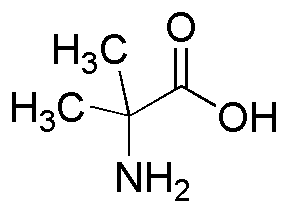a-Aminoisobutyric acid is widely utilized in research focused on:
- Pharmaceutical Development: This compound serves as a building block in the synthesis of various pharmaceuticals, particularly in the development of drugs targeting neurological disorders.
- Amino Acid Supplementation: It is used in dietary supplements aimed at enhancing muscle growth and recovery, making it popular among athletes and fitness enthusiasts.
- Biochemical Research: Researchers employ it to study metabolic pathways and enzyme functions, providing insights into cellular processes and disease mechanisms.
- Cosmetic Formulations: The compound is incorporated into skincare products for its potential benefits in skin health, contributing to formulations aimed at hydration and anti-aging.
- Animal Nutrition: It is added to animal feed to improve growth rates and feed efficiency, benefiting livestock and aquaculture industries.
Informations générales
Propriétés
Sécurité et réglementation
Applications
a-Aminoisobutyric acid is widely utilized in research focused on:
- Pharmaceutical Development: This compound serves as a building block in the synthesis of various pharmaceuticals, particularly in the development of drugs targeting neurological disorders.
- Amino Acid Supplementation: It is used in dietary supplements aimed at enhancing muscle growth and recovery, making it popular among athletes and fitness enthusiasts.
- Biochemical Research: Researchers employ it to study metabolic pathways and enzyme functions, providing insights into cellular processes and disease mechanisms.
- Cosmetic Formulations: The compound is incorporated into skincare products for its potential benefits in skin health, contributing to formulations aimed at hydration and anti-aging.
- Animal Nutrition: It is added to animal feed to improve growth rates and feed efficiency, benefiting livestock and aquaculture industries.
Documents
Fiches de données de sécurité (FDS)
La FDS fournit des informations de sécurité complètes sur la manipulation, le stockage et l’élimination du produit.
Spécifications du produit (PS)
Le PS fournit une description complète des propriétés du produit, notamment sa composition chimique, son état physique, sa pureté et les exigences de stockage. Il détaille également les plages de qualité acceptables et les applications prévues du produit.
Certificats d'analyse (COA)
Recherchez des certificats d'analyse (COA) en saisissant le numéro de lot du produit. Les numéros de lot et de lot se trouvent sur l'étiquette d'un produit, après les mots « Lot » ou « Lot de fabrication ».
Numéro de catalogue
Numéro de lot/série
Certificats d'origine (COO)
Ce certificat d'exploitation confirme le pays dans lequel le produit a été fabriqué, et détaille également les matériaux et composants utilisés et s'il est issu de sources naturelles, synthétiques ou autres sources spécifiques. Ce certificat peut être requis pour les douanes, le commerce et la conformité réglementaire.
Numéro de catalogue
Numéro de lot/série
Fiches de données de sécurité (FDS)
La FDS fournit des informations de sécurité complètes sur la manipulation, le stockage et l’élimination du produit.
DownloadSpécifications du produit (PS)
Le PS fournit une description complète des propriétés du produit, notamment sa composition chimique, son état physique, sa pureté et les exigences de stockage. Il détaille également les plages de qualité acceptables et les applications prévues du produit.
DownloadCertificats d'analyse (COA)
Recherchez des certificats d'analyse (COA) en saisissant le numéro de lot du produit. Les numéros de lot et de lot se trouvent sur l'étiquette d'un produit, après les mots « Lot » ou « Lot de fabrication ».
Numéro de catalogue
Numéro de lot/série
Certificats d'origine (COO)
Ce certificat d'exploitation confirme le pays dans lequel le produit a été fabriqué, et détaille également les matériaux et composants utilisés et s'il est issu de sources naturelles, synthétiques ou autres sources spécifiques. Ce certificat peut être requis pour les douanes, le commerce et la conformité réglementaire.


